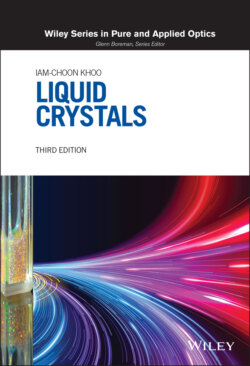Читать книгу Liquid Crystals - Iam-Choon Khoo - Страница 44
3.2.2. Elastic Constants, Free Energies, and Molecular Fields
ОглавлениеUpon application of an external perturbation field, a nematic liquid crystal will undergo deformation just as any solid. There is, however, an important difference. A good example is shown in Figure 3.1a, which depicts a “solid” subjected to torsion, with one end fixed. In ordinary solids, this would create very large stress, arising from the fact that the molecules are translationally displaced by the torsional stress. On the other hand, such twist deformations in liquid crystals, owing to the fluidity of the molecules, simply involve a rotation of the molecules in the direction of the torque; there is no translational displacement of the center of gravity of the molecules, and thus, the elastic energy involved is quite small. Similarly, other types of deformations such as splay and bend deformations, as shown in Figure 3.1b and c, respectively, involving mainly changes in the director axis , will incur much less elastic energy change than the corresponding ones in ordinary solids. It is evident from Figure 3.1a–c that the splay and bend deformations necessarily involve flow of the liquid crystal, whereas the twist deformation does not. We will return to these couplings between flow and director axis deformation in Section 3.5.
Twist, splay, and bend are the three principal distinct director axis deformations in nematic liquid crystals. Since they correspond to spatial changes in , the basic parameters involved in the deformation energies are various spatial derivatives (i.e. curvatures of , such as and , etc.). Following the theoretical formalism first developed by Frank [1], the free‐energy densities (in units of energy per volume) associated with these deformations are given by
(3.3)
(3.5)
where K1, K2, and K3 are the respective Frank elastic constants.
In general, the three elastic constants are different in magnitude. Typically, they are on the order of 10−6 dyne in centimeter‐gram‐second (cgs) units (or 10−11 N in meter‐kilogram‐second [mks] units). For p‐methoxybenzylidene‐p′‐butylaniline (MBBA), K1, K2, and K3 are, respectively, 5.8 × 10−7, 3.4 × 10−7, and 7 × 10−7 dyne. For almost all nematics K3 is the largest, as a result of the rigid‐rod shape of the molecules.
In general, more than one form of deformation will be induced by an applied external field. If all three forms of deformation are created, the total distortion free‐energy density is given by
This expression, and the resulting equations of motion and analysis, can be greatly simplified if one makes a frequently used assumption, namely, the one‐constant approximation (K1 = K2 = K3 = K). In this case, Eq. (3.6) becomes
Equation (3.6) or its simplified version, Eq. (3.7), describes the deformation of the director axis vector field in the bulk of the nematic liquid crystal. A complete description should include the surface interaction energy at the nematic liquid crystal cell boundaries. To account for this, the total energy density of the system should be
(3.8)
where the surface energy term is dependent on the surface treatment. In other words, the equilibrium configuration of the nematic liquid crystal is obtained by a minimization of the total free energy of the system, . If external fields (electric, magnetic, or optical) are applied, the corresponding free‐energy terms (see the following sections) will be added to the total free‐energy expression.
Under the so‐called hard‐boundary condition, in which the liquid crystal molecules are strongly anchored to the boundary and do not respond to the applied perturbation fields (see Figure 3.2), the surface energy may thus be regarded as a constant; the surface interactions therefore do not enter into the dynamical equations describing the field‐induced effects in nematic liquid crystals.
On the other hand, if the molecules are not strongly anchored to the boundary, that is, the so‐called soft‐boundary condition (Figure 3.3), an applied field will perturb the orientation of the molecules at the cell boundaries. In this case, a quantitative description of the dynamics of the field‐induced effects must account for these surface energy terms. A good account of surface energy interaction may be found in the work of Barbero and Simoni [4], which treats the case of optical‐field‐induced effects in a hybrid aligned nematic liquid crystal cell.
Figure 3.2. A homeotropic nematic liquid crystal with strong surface anchoring: (a) external field off; (b) external field on – only the bulk director axis is deformed.
Figure 3.3. Soft‐boundary condition. The applied field will reorient both the surface and bulk director axis.
From Eq. (3.6) for the free energy, one can obtain the corresponding so‐called molecular fields using the Lagrange equation [3]. In spatial coordinate component form, we have
where
(3.10)
More explicitly, Eq. (3.9) gives, for the total molecular field associated with splay, twist, and bend deformations,
and torque , where
(3.12)
(3.14)
with and .
